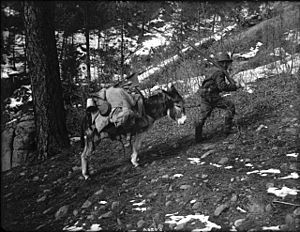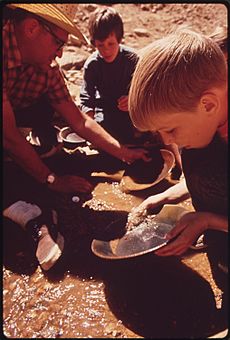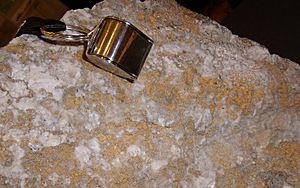Prospecting facts for kids
Prospecting is like a treasure hunt for valuable things hidden in the Earth! It's the first step in finding minerals, fossils, or precious metals like gold. People who do this are called prospectors. Sometimes, this activity is also called fossicking.
Think of prospecting as a small-scale search. It's different from "mineral exploration," which is a much bigger, organized effort by large companies. These companies use lots of tools and people to find huge amounts of valuable rock, called ore, that can be mined for profit.
Prospecting involves a lot of physical work. Prospectors often walk or ride horses through the countryside. They might pan for gold in rivers, sift through dirt, or carefully check rocks for signs of minerals. In some places, a prospector needs to "stake a claim." This means marking out an area of land they want to search and registering it. In other places, people can prospect on public land without needing a special claim.
Contents
How Prospectors Found Treasure Long Ago
In the past, prospectors searched by hand. They would walk through wild areas, especially along creek beds and hills. They often got down on their hands and knees to look closely at the rocks.
If they were looking for gold, they would pan in every stream. They hoped to see a "show of colour," which meant tiny flakes of gold in their pan.
Once they found a small amount of minerals, called a "show," they would work harder in that spot. They used tools like picks and shovels. Sometimes, they added simple machines like a sluice box. This helped them separate the valuable materials from the loose soil and rocks. For other metals, they would dig out the rock by hand. Then they crushed it to separate the valuable ore from the useless rock, called gangue.
Often, these small finds didn't last long. Prospectors would soon move on, hoping to find a bigger and better discovery. But sometimes, a prospector would get lucky and "strike it rich!" When this happened, other prospectors would join them. Then, larger-scale mining would begin. Even though these are old methods, some prospectors still use them today. They often combine them with modern tools like geophysical surveys, which use magnetic or gravity readings to find minerals.
It was rare for a prospector to become wealthy, even if they made a huge discovery. For example, Paddy Hannan, who found the famous Golden Mile in Kalgoorlie, Australia, did not get rich from his find. This was a common story during the big gold rushes.
The Excitement of Gold Rushes
In the 1800s, many prospectors in the United States and Canada dreamed of finding gold and silver. They traveled across the mountains of the American West. They carried simple tools like picks, shovels, and gold pans. Most of these early prospectors had no special training. They mostly relied on good luck to find valuable deposits.
Other gold rushes happened in places like Papua New Guinea, Australia, South Africa, and South America. Each time, a prospector's successful find of gold or minerals would spark "gold fever." This led to many other prospectors rushing to the area to search for their own treasure.
Modern Prospecting Methods
Today, prospectors use more than just luck. They often have training and study geology, which is the science of Earth's rocks and minerals. They also use modern technology.
Knowing where prospecting happened before can help find new areas to search. Modern prospecting includes creating geological maps of an area. It also involves testing rock samples to see what minerals they contain. Sometimes, a prospector's good intuition also plays a part!
Using Metal Detectors
Metal detectors are very helpful for gold prospectors. They are good at finding gold nuggets hidden in the soil. They can often detect gold down to about 1 metre (3 feet) deep. How well they work also depends on the prospector's skill and hearing.
Special magnetic tools can also help. They separate magnetic parts of the soil from non-magnetic parts. This makes it easier to pan or sieve for gold.
The Prospecting Pickaxe
A prospecting pickaxe is a tool used to scrape at rocks and minerals. This helps prospectors get small samples to test for tiny amounts of ore. Some modern prospecting pickaxes even have magnets. These magnets help collect magnetic ores. Prospecting pickaxes usually have a triangular head with a very sharp point.
See also
 In Spanish: Prospección para niños
In Spanish: Prospección para niños





